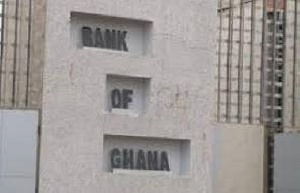Out of the GH¢41.15 billion raised from bond issuance between January and June, this year, GH¢30.5 billion was used to settle maturing securities, the Bank of Ghana (BoG) has revealed.
The amount represents about 75% of the GH¢41.15 billion leaving GH¢10.65 billion, representing 25% used to re-profile the country’ debt.
According to the BoG, Ghana’s total public debt as at the end of May 2017 stood at GH¢137.2 billion from GH¢122.6 billion at the end of 2016. This means GH¢14.6billion has been added to the total public debt within six months.
The regulator explained that the increase in the debt stock was on account of issuance of long-dated domestic bonds in line with government’s debt management strategy of re-profiling the public debt, extending the yield as well as extending the yielding curve.
Analysts explained that the increase in the public debt stock was the result of deficit financing and payment of inherited arrears and debts.
Economist Dr Lord Mensah of the University of Ghana Business School told The Finder the use of 75% of issued bonds to settle maturing securities is indicative of the fact that “as a country we are highly unproductive in terms of the debts we accrued.
“In measuring debt levels, it is tied to a country’s GDP and so the assumption is that whatever you borrow you put it into the economy so it reflects on the GDP; so then if your debt is growing and the GDP is not growing or growing at a slower pace then there is a problem,” Dr Mensah explained.
He wondered what the monies borrowed in the past were used for, noting “the ideal situation is that when you borrow, you use a small fraction of it to complement the cash flows of earlier projects but now we are using over 70% to retire old debts, meaning then that capital investments will suffer.
Fiscal operations for the year to April 2017 resulted in a cash deficit of 1.5 per cent of GDP, within the set target of 2.2 per cent, mainly due to expenditure controls even as revenue fell below target.
Provisional data shows that total revenue and grants for January to April 2017 were 5.4 per cent of GDP against a target of 6.5 per cent.
GH¢27.3 as interest cost and deficit financing for 2017
Projected interest cost and deficit financing for 2017, amounts to GH¢27.3 billion.
Government borrowed GH¢41.15 billion the first six months of this year, the total public debt only witnessed GH¢14.6billion within the period This is because part of the money borrowed was used to pay off part of the country’s debt.
The total public debt for the country as at May, this year, has reached ¢137.2 billion putting the debt-to-GDP ratio at 67.5%. Per the data from Bank of Ghana external debt accounted for $17.1 billion while domestic debt stood at almost ¢63.9 billion.
End of 2016 budget deficit was 9% but the new government projected to reduce it 6.5% by the end of this year.
The 6.5% projected budget deficit for 2017 represents GH¢13.2 billion as the difference between the government’s revenue expectations for 2017 compared to the expenditure targets for the period.
Government’s total revenue target for 2017 is estimated at GH¢44.9billion against a targeted expenditure of GH¢58.1 billion, representing 28.6% of GDP. How the deficit is being financed Government revealed that the deficit will be financed by domestic and international sources.
Net domestic financing will amount to GH¢14.6 billion, equivalent to 7.1% of GDP while foreign financing is expected to reach GH¢1.3 billion, representing 0.6% of GDP.
GH¢14.1 billion interest cost for 2017
The interest cost on Ghana’s debt has also increased and will amount to an estimated GH¢14.1 billion in 2017.
30% of revenue goes into debt
A report, jointly published by seven organizations in the last quarter of 2016 revealed that Ghana is in a debt crisis because the country is losing around 30% of government revenue in external debt payments each year.
Loans being used well enough
It attributed the situation to a combination of the fall in the price of commodities and the loans not being used well enough to ensure they could be repaid.
Why the debt is increasing
The authors said such huge payments are only possible because Ghana has been able to take on more loans from institutions, such as the International Monetary Fund (IMF), which are used to pay the interest on debts to previous lenders, whilst the overall size of the debt increases.
According to the report, the IMF estimates that the Ghanaian government’s external debt payments in 2016 will be 29% of revenue, which is well above the 18–22%, that the IMF normally regards as the upper limit of sustainability payments. The situation is expected to stay well above 20% of revenue until, at least, 2035.
The report noted that this is only considered possible due to a combination of very optimistic expectations and requirements for large spending cuts and tax increases, the very things the IMF has been criticising the European Union for, especially in the case of Greece.
Ghana’s debt crisis
It explained that Ghana’s crisis is the result of a gradual increase in lending and borrowing off the back of the discovery of oil and high commodity prices. “More money was then borrowed following the fall in the price of oil and other commodities since 2013, to try to deal with the impact of the commodity price crash, whilst the relative size of the debt also grew because of the fall in the value of the cedi against the dollar.
“The underlying causes of the return to a debt crisis are, therefore, the continued dependence on commodity exports, as well as borrowing and lending not being responsible enough, meaning that new debts do not generate sufficient revenue to enable them to be repaid,” it added. The report is titled ‘The Fall and Rise of Ghana’s Debt: How a New Debt Trap Has Been Set’ and was published this month.
The report was jointly published by the Integrated Social Development Centre Ghana, Jubilee Debt Campaign UK, SEND Ghana, WAZOBA Ghana, All-Afrikan Networking Community Link for International Development, Kilombo Ghana and Abibimman Foundation Ghana.
Jubilee Debt Campaign is part of a global movement demanding freedom from the slavery of unjust debts and a new, financial system that puts people first.
GDP figures 2016 GDP = GH¢167,315.5 million 2017 GDP Projection = GH¢203,410.5 million
Business News of Tuesday, 25 July 2017
Source: thefinderonline.com

















